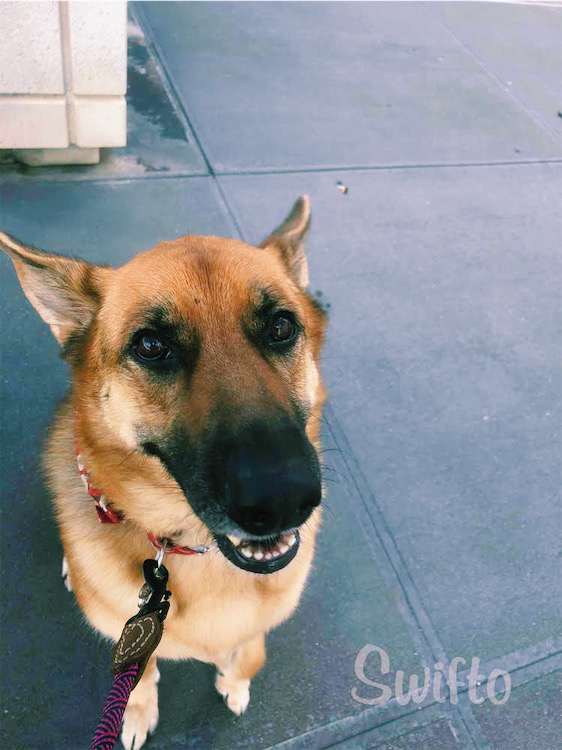Tricks are equal parts useful, important, and cute. At the end of the day, dog tricks are pretty similar to learning a sport or playing the piano, as they’re both learned mental and physical skills. Simple obedience commands are similar to tricks and both benefit you and your dog in a plethora of ways. Both should be taught precisely and practiced smartly and thoroughly in order to reap the benefits of a trained dog.
A good thing about teaching your dog tricks is that everyone watching laughs and smiles, acting as positive reinforcement and a reward. Over time, the trick will be, in itself, a reward and will be self-reinforced. This means that the tricks act as rewards for other actions or exercises. For example, if your dog remains calm when people come over, asking him to “Give me a high five!” acts as his reward. But, you don’t need to over work your dog or try to perfect the art of pup tricks… enjoy it! This is a time to laugh and bond with your dog while also teaching him valuable and useful behaviors.
How we communicate and connect with our dogs is vital to how they react to behavior modification and training. Your body language is important and your dog will definitely pick up on it. If you’re calm, then he will also be calm. Remain relaxed and patient, as your dog does not yet know the meaning of “sit” and has no idea what you’re asking of him. It’s also important to keep your dog’s attention as long as possible and to pause when he stops paying attention. If he becomes uninterested or runs away, you’ve done too much. This is a way of your dog communicating that he’s done enough for the session and is too stimulated.
Roll over is a classic and adorable dog trick that is easy to learn. If your dog knows the “down” position, ask him to perform that first. If he does not, gently lure him into the lying down position with treats and a lovable tone of voice. After, kneel down next to your dog and hold a treat near his nose. Next, move your hand with the treat away from his nose and toward his shoulder, making him roll on his side. Repeat this several times and reward him every single time. Once he’s lying flat, continue the movement of your hand from the shoulder to the backbone, keeping the treat visible. Follow through until your dog rolls onto his other side and then repeat several times. When your dog consistently performs this motion, start saying “Rollover!” to associate the term with the action. Over time, scale down your hand motions until your dog can perform the trick when prompted only by the word. Don’t forget to give him the highest of praises and yummy treats for all his hard work!
Probably the most common trick of all, fetch, is completely subjective and based on your dog’s behaviors. Some seem to have a predisposition for playing fetch and will chase and retrieve what you throw without having prior training. For the other dogs, it’s typical to chase the object but not return it or to just stare at you and wonder why you jettisoned a perfectly new tennis ball. The first step is to teach him how to chase the object that you want him to retrieve. You can do this by offering treats, using loads of affection, and remaining calm and loving. Regardless of the methodology, the process remains essentially the same. Encourage your dog to get the object, reward him upon doing so, and then take the object away.
For added motivation, hold your dog back after you throw the object, that way he’ll be tugging against you and begging to chase it. Do this several times in a row until you feel your dog is ready to actually chase after it. Start by throwing the object a short distance. Reward your dog immediately after he goes for it and repeat this until your dog consistently chases the object each time you throw it. After Fido has successfully mastered the chase, he now will learn the art of retrieval. If your dog doesn’t bring the object back to you, try using a second object to lure him toward you. For example, once he has the first object, make sure he sees the second one and then throw it in the opposite direction. It’s okay if your dog doesn’t run back with the first object because this will definitely get him used to the idea of running back to you after catching the object.
Once your pup gets the gist of it, call him back to you while he still has the object and ask him to drop it. Even if your dog doesn’t know that command, showing the second object to him will likely cause him to drop the first one in order to go for the second one. Gradually, he will understand that dropping the object when returning back to you means you will throw it again. It’s helpful to pick an object that your dog likes, such as his favorite toy or a bone. Your dog will not chase after something he doesn’t like so experiment with different objects to find which one works best. The idea of teaching your dog different tricks is great and motivating.
The various tricks and training methods keep dogs mentally stimulated and provide endless health benefits. Not only do tricks help your dog, but they help you everyday! Being committed to training is fantastic and will improve mental abilities and functions but remember to not push your dog too far. Know his limits and respect his progress. Most importantly, have fun and enjoy the endless smiles and joy that cute dog tricks grace us with.
Looking to book a dog walk?


